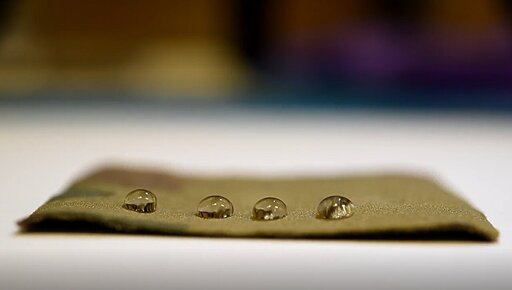Researchers create safer nonstick surface, cutting use of 'forever chemicals'
-
This post did not contain any content.

Researchers create safer nonstick surface, cutting use of 'forever chemicals'
A new material developed by researchers from University of Toronto Engineering could offer a safer alternative to the nonstick chemicals commonly used in cookware and other applications.
(phys.org)
-
 S Science shared this topic on
S Science shared this topic on
-
This post did not contain any content.

Researchers create safer nonstick surface, cutting use of 'forever chemicals'
A new material developed by researchers from University of Toronto Engineering could offer a safer alternative to the nonstick chemicals commonly used in cookware and other applications.
(phys.org)
The nonstick surface?

-
This post did not contain any content.

Researchers create safer nonstick surface, cutting use of 'forever chemicals'
A new material developed by researchers from University of Toronto Engineering could offer a safer alternative to the nonstick chemicals commonly used in cookware and other applications.
(phys.org)
tl;dr: silicone with little tiny PFAS tips. Supposedly the single molecule is safer than the long chains in Teflon.
-
The nonstick surface?

Also, carbon steel, stainless steel. That’s right–stainless steel is nonstick if you just use it correctly. You don’t need special “non-stick” cookware. We’ve had it all this time.
-
This post did not contain any content.

Researchers create safer nonstick surface, cutting use of 'forever chemicals'
A new material developed by researchers from University of Toronto Engineering could offer a safer alternative to the nonstick chemicals commonly used in cookware and other applications.
(phys.org)
“cutting use” in this context meaning “limiting use” rather than “eliminating use”. Great job no notes
-
tl;dr: silicone with little tiny PFAS tips. Supposedly the single molecule is safer than the long chains in Teflon.
You’re going to make me read the article aren’t you……
Fine.
Ok I read it. This is…. A reasonable tldr. I was hoping for more on the manufacturing. As I understood it, the real issue with teflon was the manufacturing, and the resulting product was largely not a big deal, the molecules are too big for our body’s to do much with
-
The nonstick surface?

Yes! I’ve tried all the others, ceramic included… nothing beats cared-for cast iron. Yes, you use more oil. Yes, you’ve gotta reseason it once every few years.
I always rolled my eyes at the cast iron zealots on Reddit, but with pets in the house, and cooking a lot, it just works.
-
This post did not contain any content.

Researchers create safer nonstick surface, cutting use of 'forever chemicals'
A new material developed by researchers from University of Toronto Engineering could offer a safer alternative to the nonstick chemicals commonly used in cookware and other applications.
(phys.org)
The safest nonstick cookware is: Cast Iron, Carbon Steel, and Stainless Steel. However, you need to learn/develop those skills to make use of those nonstick properties. If you are lazy, you can use coated (aka Teflon) cookware and halve or more your lifetime. It’s your choice.
-
Also, carbon steel, stainless steel. That’s right–stainless steel is nonstick if you just use it correctly. You don’t need special “non-stick” cookware. We’ve had it all this time.
stainless steel is nonstick if you just use it correctly.
Can you explain how to use it correctly?
-
stainless steel is nonstick if you just use it correctly.
Can you explain how to use it correctly?
With pans that have a non-stick coating, you want to add your fat (butter or oil usually) before you heat the pan.
With stainless steel pans, it is the opposite. You want to heat your pan up and then add your fat.
If you do either of those in the wrong order, you’ll get food sticking to your pan.
That really covers most people’s problems when cooking with stainless steel. They don’t wait long enough to have their pan heat up before they add their butter or oil.
-
tl;dr: silicone with little tiny PFAS tips. Supposedly the single molecule is safer than the long chains in Teflon.
I thought teflon being long is what made it safe. It’s the smaller molecules used in the process of making the long Teflon that are bad.
-
stainless steel is nonstick if you just use it correctly.
Can you explain how to use it correctly?
Same principle.
Cast iron, you just do that, too, but more, and it’s also to prevent rust.
Honestly, ever since I learned this, I’ve used my cast iron less.
Pro note: scientists are finding that oil smoke is wayyyyy worse than we previously thought. Get a really good hood and turn it on. Like farts, if you can smell it, you’re breathing it.
-
I thought teflon being long is what made it safe. It’s the smaller molecules used in the process of making the long Teflon that are bad.
I heard teflon is delicious and nutritious
-
With pans that have a non-stick coating, you want to add your fat (butter or oil usually) before you heat the pan.
With stainless steel pans, it is the opposite. You want to heat your pan up and then add your fat.
If you do either of those in the wrong order, you’ll get food sticking to your pan.
That really covers most people’s problems when cooking with stainless steel. They don’t wait long enough to have their pan heat up before they add their butter or oil.
They don’t wait long enough to have their pan heat up before they add their butter or oil.
That’s the real problem there. The oil should smoke a little when you add it, that means the pan is hot enough. You can check by flicking some water in the pan; if the water drops bead up and skate around the pan like they’re on ice (Leidenfrost effect), it’s ready. If it immediately fizzles and evaporates it’s not hot enough.
-
This post did not contain any content.

Researchers create safer nonstick surface, cutting use of 'forever chemicals'
A new material developed by researchers from University of Toronto Engineering could offer a safer alternative to the nonstick chemicals commonly used in cookware and other applications.
(phys.org)
…until someone figures out what’s wrong with it…
-
I thought teflon being long is what made it safe. It’s the smaller molecules used in the process of making the long Teflon that are bad.
A little column A, a little column B. The problem isn’t really the length of the molecules, but the carbon fluorine bonds in it. Those are what make them so stable and why this compound class is used at all.
Bigger molecules are not so easy to get through your cell membranes, which is why they argue that they are safer. Problem is, that over time they do kinda break down into smaller molecules. So over longer time frame they release unsafe molecules in small amounts.
Shorter fluorinated compounds are faster going into your cells but also out of them.
Then the question is how much damage do those compounds while in your body? That only time (and studies) will tell.
But honestly? After working on the analytical part of that field for a bit and seeing how the industry bullshitted their way through till now? I don’t trust them one bit.
-
The safest nonstick cookware is: Cast Iron, Carbon Steel, and Stainless Steel. However, you need to learn/develop those skills to make use of those nonstick properties. If you are lazy, you can use coated (aka Teflon) cookware and halve or more your lifetime. It’s your choice.
Stainless Steel is just straight up not non stick.
It’s not designed to build up a patina.
Also, why everyone always leaving out coated cast iron - it’s not fully non stick but it’s stick resistant at least and doesn’t have to be babied like cast iron.
